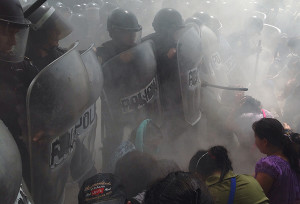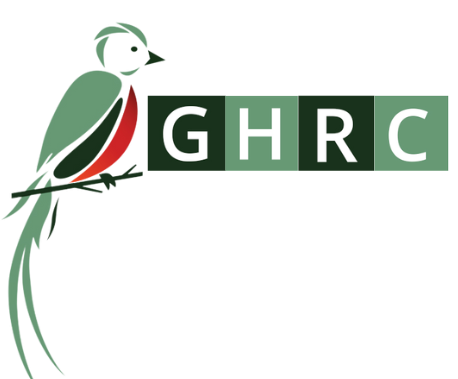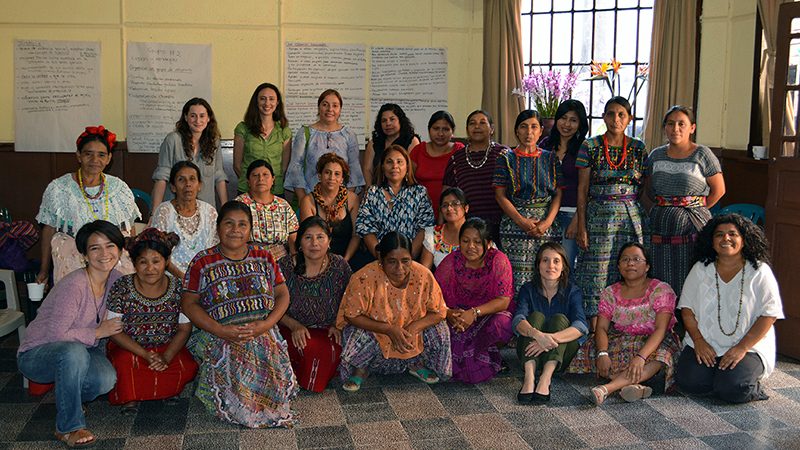FOR IMMEDIATE RELEASE
 May 24, 2014 (San José del Golfo, Guatemala) — At 4:30 in the morning on Friday, May 23, a convoy of heavy machinery showed up at the anti-mining protest and blockade known as La Puya, accompanied by an estimated 100 riot police. By late afternoon, the site was a battle zone filled with tear gas; at least 20 people were injured and seven were taken to the hospital in Guatemala City.
May 24, 2014 (San José del Golfo, Guatemala) — At 4:30 in the morning on Friday, May 23, a convoy of heavy machinery showed up at the anti-mining protest and blockade known as La Puya, accompanied by an estimated 100 riot police. By late afternoon, the site was a battle zone filled with tear gas; at least 20 people were injured and seven were taken to the hospital in Guatemala City.
“The eviction was brutal and violent,” said Rob Mercatante, Director the GHRC’s Guatemala office, who witnessed the events first-hand alongside other international observers.
At about 3:45pm, police gave protesters — who were unarmed — 10 minutes to move from the road. Women sang and prayed for peace. “Yes to life, no to mining!” they cried, as police began to shoot tear gas and flash bombs into the crowd. One woman received serious head injuries after being struck in the face with a tear gas canister. Heavily armed, police were also captured on video hurling rocks and pieces of firewood into the crowd.
Members of La Puya documented the violence via social media: “There are men and women injured. The riot police don’t respect age or gender. Boys and girls are in the middle. There are no ambulances and no medical help. They are hurting the elderly.”
Several national and international civil society groups, including the UN High Commissioner for Human Rights in Guatemala, denounced the attack. The Guatemalan Human Rights Ombudsman’s Office also stated: “What happened at La Puya, San Jose del Golfo, in order to allow passage of heavy machinery into the El Tambor mine is reprehensible.”
Since March 2, 2012, residents from around the proposed site of the El Tambor Mine, an hour outside of Guatemala City, have maintained a peaceful, 24-hour blockade at the entrance to the mine, which is owned by the Reno-based engineering firm, Kappes, Cassiday & Associates. Residents are concerned about the health and environmental impacts of the mine and they are committed to defending their right to be consulted about projects in the community that would affect their lives and livelihoods.
The attack on Friday was not the first incident of violence against the people of La Puya. In June 2012, community leader Yolanda Oquelí was shot on her way home from the roadblock by unknown gunmen. Security guards hired by EXMINGUA were convicted of intimidating journalists at the roadblock in December 2012. In addition, The Interior Ministry has sent hundreds of police officers, including riot police, on multiple prior occasions to escort the mine company’s machinery and to attempt to enter the mine site by force. Until Friday, those efforts were successfully rebuffed by the communities.
“For two years, the protest at La Puya has been symbolic of the power of non-violent resistance,” said GHRC Director Kelsey Alford-Jones. “The Guatemalan government has been incapable of resolving conflict through dialogue and Friday’s eviction follows a pattern of violent police action used against citizens engaged in the legitimate defense of their rights.”
On Monday, May 26, over 500 residents from neighboring municipalities marched to the mine site in a show of solidarity with La Puya. Members of the movement have expressed that they are determined to continue their resistance to the El Tambor mine.
Background:
The environmental movement La Puya began with a single act of civil disobedience, when one woman — concerned by the sudden arrival of a gold mining operation in her community — decided to park her car sidewise along the road in order to stop a convoy of massive mining machinery. Others quickly moved to join her, and the impromptu roadside gathering of community members became, essentially, a human roadblock. Over time, the movement became known as the “Communities in Resistance,” or simply as “La Puya.” Community members settled into shifts of 24 hours a day, 7 days a week. Until the eviction on Friday, the blockade at La Puya had been peacefully preventing equipment from entering the Tambor mine site for over two years.
The proposed mining project, first owned by Canadian company Radius Gold and later sold to US Engineering firm Kappes, Cassiday & Associates (KCA), has received a dozen mining licenses for exploration and extraction over an area of 20 square kilometers. After Radius Gold acquired the land, almost a decade passed while experts tested different locations for gold without the communities’ knowledge.
The Communities in Resistance are concerned about the mine’s health, social, and environmental impacts. They maintain that the government has not complied with legal obligations to consult with communities about projects that would affect them. They were not given the opportunity to read and submit comments on the mining company’s environmental impact assessment.
Concerns about the impact of the project on water and health are supported by an evaluation carried out by hydrogeology and geochemistry expert Robert Moran. He states in a May 22, 2014 review that the Environmental Impact Assessment is the worst quality that he has seen out of hundreds that he has reviewed in his 42 years of experience. While the process has been slow, all parties were working toward an agreement to review the EIA to address the report’s failure to consider water contamination due to high levels of arsenic already present in the soil.
Representatives of the anti-mine movement have been participating in an ongoing negotiation process with the government. The process was stalled earlier this week when the government refused to allow the conversations to be recorded. During the standoff on Friday, the Vice-Minister of the Interior insinuated that the government had agreed to accompany the mining equipment because the dialogue had been effectively “broken.” Community members at La Puya reiterate that they want to complete the negotiation process with the government, but with transparency.
Contact: Kelsey Alford-Jones, GHRC Executive Director
Email: kajones@ghrc-usa.org
Phone: (202) 520-3083


